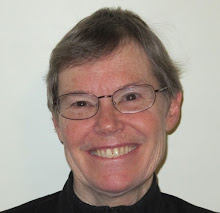This month I have written about playing inside the barn. "Playing in an old barn" was published in The Danvers Herald on Thursday May 5, 2011. (See text copied below.)
I was happy to find these old photographs (taken in 1956 by my father, copied from slides to prints years ago, and now scanned from the prints into my computer).
We loved to play in these fancy stalls, pretending to be horses, or more often, riding on top of the stall walls as jockeys in a race. To climb up so high, we'd have to move some boxes or furniture into place; our legs were too short to get up there without a platform to climb on.
Playing in an old barn
By Sandy Nichols Ward
There was an old barn on the hill above my childhood home in Danvers. The wood on the barn's exterior was weathered, but not uniformly. We could see a faint pattern high on the front above the central doors. Once upon a time numbers had been painted or attached there and we could still read the date on the faded wood: 1856.
I loved playing in that barn with my sister and friends. We pretended to be horses in the wooden stalls, or we became jockeys riding the walls between the stalls. We explored back rooms and laughed at the old-fashioned ads in the musty magazines found on the floor. We gathered up old leather straps, reins and stirrups, and used this tack on our wooden horses. We tried to roll the antique fire cart back and forth. It had a huge handle on front, designed to be pulled by strong firemen, and a heavy coil of flattened canvas hose wrapped around the wheel axle. We could barely move it.
Down under the barn, accessible by doors downhill on the south side, was a dark dusty storage area containing piles of lumber and the remains of several long-neglected wagons or carriages. One of them was a "surrey," my mother said. I'd heard of a "surrey with a fringe on top" but this one no longer had a top or a fringe. Nearby was a much more interesting vehicle -- a old black carriage. The leather was cracked, but the doors opened and we could get inside and bounce the carriage up and down on its springs. It was fun pretending this was a stage coach carrying us westward, as in the cowboy shows we watched on TV.
Upstairs in the barn was a huge open room or hay loft. When it was filled with hay we were NOT supposed to play there. The hay belonged to a Danvers farmer who was probably paying rent to use this storage space. The barn was supposed to be locked, but some of the boys in the neighborhood helped us gain entry. It was exciting to sneak into the dark barn, climb up the stairs, climb high on the piles of hay bales, and jump from level to level, sometimes breaking apart the bales as we played. Jumping in the hay was fun! The spankings that followed were not.
Without hay, the upper room was a lovely wide-open space for games and parties. We'd climb the steep, narrow stairs and enjoy running around in that room. I recall playing "Red light, Green light!" with friends. I remember bobbing for apples in a big wash tub on Halloween after surviving the horrors of the haunted barn below, where my father had set up spooky scenes, noises, and experiences in each stall, and we had to grope our way in darkness, one hand following an old rope guiding us forward.
A second staircase, wider and safer than the first, was later added at the back of the barn and an upright piano was brought upstairs for use during parties and barn dances. My parents were avid square dancers and liked to invite friends to dance. During one well-attended barn dance, someone on the lower level was alarmed to notice how much the ceiling was moving. My father investigated and guessed that the center section of that upper floor was not part of the original barn. Probably a hay wagon could be driven in and hay pitched up to lofts on each side. No one knew when that center section had been floored, nor how well constructed it was (or wasn't). From then on, dancers were instructed to dance on the sides, avoiding the bouncy middle section. As I grew older I participated in many square dances with my parents, mostly held in the basement of the First Church in Salem, where there was no danger of a collapsing floor. The piano in the old barn became neglected and went out of tune. I recall getting in trouble for snapping ivory pieces off those piano keys; I didn't see why it mattered since no one was using that old piano anymore.
That 1856 barn and the hill it sat on were removed to make way for the construction of Route 95 in the early 1970's, but the barn lives on in my memories.





2 comments:
Hi Sandy--I am enjoying the barn pictures. I remember roaming through there a few times as I was doing yard work for your mother and father--I mowed the lawn one spring/summer--probably my first real paying job. I think I remember that the power lawn mower was kept in the barn. I also think that your mother's horse was stabled under the barn adjacent to the paddock.
Best regards,
Paul
Yes, in later years the lower level of the barn was cleared out to make way for horses. My mother kept a horse (or sometimes two) there with easy access to the paddock.
Post a Comment